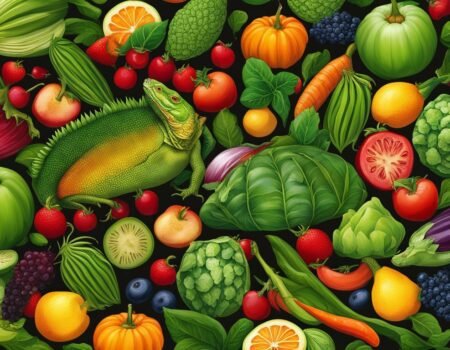Did you know that a well-balanced and nutritious diet is essential for the health and well-being of your pet iguana? Feeding your iguana the right combination of vegetables and fruits can make a significant impact on their overall health and longevity. So, if you want to ensure that your scaly friend thrives and lives its best life, it’s time to dive into the world of the top iguana diet!
Key Takeaways:
- Feeding your iguana a balanced and nutritious diet is crucial for their health and well-being.
- Include a variety of vegetables and fruits in your iguana’s diet to provide necessary nutrients.
- Avoid feeding your iguana harmful or toxic foods that can negatively impact their health.
- Consult with a veterinarian or reptile specialist for specific dietary recommendations based on your iguana’s age, size, and health condition.
- Regularly monitor your iguana’s body condition and adjust their diet if necessary to maintain a healthy weight.
The Natural History of Iguanas and Common Breeds
Iguanas, particularly the green iguana (Iguana iguana), are native to Central America, South America, and the Caribbean. These reptiles have a fascinating natural history and are known for their unique characteristics. Green iguanas, in particular, are widely kept as pets due to their vibrant colors and docile nature.
Within the cyclura family, there are other breeds of iguanas that also make good pets, such as the rhinoceros iguana, grand cayman iguana, and cuban rock iguana. Each breed has its own distinct characteristics, size, and habitat needs compared to the green iguana.
| Breed | Characteristics | Size | Preferred Habitat |
|---|---|---|---|
| Green Iguana | Vibrant green color, docile nature | 4 to 6 feet in length | Tropical rainforests and forests near bodies of water |
| Rhinoceros Iguana | Bumpy skin resembling a rhinoceros, territorial behavior | 3 to 4.5 feet in length | Rocky coastal areas and dry forests |
| Grand Cayman Iguana | Blue-gray color, critically endangered | 3 to 4 feet in length | Tropical dry forests and rocky coastlines |
| Cuban Rock Iguana | Dark brown color, short spines on the back | 2 to 4 feet in length | Rocky habitats and dry forests |
Regardless of the breed, all iguanas require specific husbandry and diet requirements to thrive in captivity. Providing a suitable environment that mimics their natural habitat is essential for their well-being.
Proper Care and Housing for Your Iguana
Providing the right housing is essential for the well-being of your iguana. A well-designed iguana enclosure or tank is crucial for creating a comfortable and safe habitat.
Proper Ventilation
Ensure that the enclosure has proper ventilation to prevent the growth of mold or fungus. Sufficient airflow helps maintain a healthy environment for your iguana.
Ideal Cage Setup
Choose an iguana tank that is appropriate for your iguana’s age and size. The tank should provide enough space for your iguana to climb, stretch, and turn fully. A suitable cage setup is essential for your iguana’s physical and mental well-being.
Substrate Selection
When selecting a substrate for your iguana’s enclosure, consider materials that are safe and easy to clean. Options such as Repticarpet or paper towels can provide a hygienic and low-maintenance substrate for your iguana.
Basking and Cooling Areas
Creating designated basking and cooling areas is important for your iguana’s thermoregulation. Ensure that your pet has access to a basking spot with proper lighting and temperature for digestion and metabolism. Additionally, provide a cooler area for your iguana to regulate body temperature and prevent overheating.
Proper care and housing play a crucial role in the overall health and well-being of your iguana. By setting up an appropriate enclosure with adequate ventilation, substrate, and designated basking and cooling areas, you can create a comfortable and thriving habitat for your pet.
| Key Components of an Ideal Iguana Enclosure |
|---|
| Proper Ventilation |
| Ideal Cage Setup |
| Safe and Easy-to-Clean Substrate |
| Basking and Cooling Areas |
Creating an Enriching Environment for Your Iguana
Your iguana’s enclosure can be more than just a place to live—it can be an enriching environment that promotes mental and physical stimulation. By incorporating certain elements into their habitat, you can provide your iguana with a space that mimics their natural surroundings and encourages their natural behaviors.
Enrichment Toys for Mental Stimulation
Enrichment toys play a vital role in keeping your iguana mentally engaged and stimulated. You can introduce live plants that are safe for iguanas, such as pothos or hibiscus, which not only make the enclosure visually appealing but also provide hiding spots for your pet. Another option is puzzle toys or foraging toys that require your iguana to solve a challenge to obtain treats or food. This engages their problem-solving skills and keeps them active.
Creating Hiding Spots
In the wild, iguanas have ample opportunities to hide and seek shelter. Replicating this natural behavior in captivity is crucial for their mental well-being. You can create hiding spots by incorporating rocks, tunnels, or branches into their enclosure. These hiding spots provide a sense of security and help reduce stress in your iguana.
Branches and Climbing Areas
Iguanas are excellent climbers, and providing them with different-shaped branches allows them to exercise their natural climbing instincts. Branches should be sturdy enough to support your iguana’s weight and positioned in a way that encourages vertical movement. This not only provides physical exercise but also helps promote healthy muscle development.
Checking for Ectoparasites
Before introducing any items into your iguana’s enclosure, it’s essential to check them for ectoparasites. Ectoparasites, such as mites or ticks, can harm your pet and introduce diseases into their habitat. Carefully inspect live plants, branches, or any other items that you plan to add to the enclosure. If you notice any signs of ectoparasites, it’s best to find alternative options or treat the items before introducing them to your iguana.
By creating an enriching environment with toys, hiding spots, and climbing areas, you can enhance your iguana’s quality of life and overall well-being. Remember to ensure the safety of all items by checking for ectoparasites beforehand. Your iguana will thank you for providing a stimulating and comfortable home.
Maintaining Proper Temperature and Humidity
Iguanas are ectothermic creatures, relying on external heat sources to regulate their body temperature. It is crucial to ensure that your pet iguana’s enclosure has the right temperature and humidity levels for its overall well-being. Failure to provide the optimal conditions can lead to health issues and discomfort for your iguana.
Heat Bulb for Thermoregulation
To create a suitable environment for your iguana, you need to incorporate a heat bulb into its enclosure. The heat bulb provides the necessary warmth for thermoregulation, allowing your iguana to regulate its body temperature effectively. This is crucial for its metabolic processes, digestion, and overall physiological functions.
Place the heat bulb at one end of the enclosure to create a temperature gradient, with the other end serving as a cool area. This allows your iguana to move freely between the warmer and cooler zones, mimicking its natural behavior in the wild.
Maintaining Humidity Levels
Humidity is another vital factor to consider when caring for your iguana. Maintaining a humidity level of 70-80% helps support its respiratory health and overall well-being. Low humidity can lead to dehydration and shedding issues, while high humidity can promote the growth of harmful bacteria and fungi.
You can maintain the appropriate humidity levels by regularly misting the enclosure with clean water or investing in a misting system. This ensures that your iguana’s skin remains hydrated and healthy.
Monitoring Humidity with a Hygrometer
To accurately monitor and maintain the humidity levels in your iguana’s enclosure, it is essential to use a hygrometer. A hygrometer measures the relative humidity, allowing you to ensure that the environment stays within the optimal range for your iguana’s well-being. Regular monitoring and adjustments will help you create a comfortable and suitable habitat for your pet.
By providing the right temperature gradient and maintaining suitable humidity levels, you can ensure the thermoregulation and overall comfort of your iguana. This will contribute to its well-being and help prevent potential health issues.
Providing a Healthy and Balanced Diet for Your Iguana
As a strict herbivore, your iguana requires a diet rich in fresh vegetables and limited fruits to maintain optimal health. You must pay close attention to their nutritional needs to ensure they receive the necessary vitamins and minerals. Let’s explore the key components of a healthy and balanced iguana diet:
1. Fresh Plant Matter
Include a variety of fresh plant matter in your iguana’s diet. Dark, leafy greens such as collard greens, kale, and mustard greens should make up the majority of their daily intake. These greens provide essential nutrients, including calcium, and help maintain a healthy digestive system. You can also rotate other vegetables like bell peppers, carrots, and squash to add variety.
2. Calcium to Phosphorus Ratio
It’s crucial to maintain the proper calcium to phosphorus ratio in your iguana’s diet. The ideal ratio is 2:1 or 3:1 in favor of calcium. Calcium is essential for skeletal health, while phosphorus should be balanced to prevent issues like metabolic bone disease. Dusting their food with a calcium supplement, specifically formulated for reptiles, can help ensure they receive enough calcium.
3. Limited Oxalates
Foods high in oxalates, such as spinach and beet greens, should be used sparingly due to their potential to bind with calcium and interfere with its absorption. While these greens can be included in your iguana’s diet, they should not be the main source of calcium. Providing a variety of greens with lower oxalate levels can help offset this potential issue.
4. Adequate Hydration
Always ensure your iguana has access to fresh water for hydration. A shallow dish or water bowl placed within their enclosure will suffice. Regularly clean and refill the water to maintain cleanliness. Additionally, consider misting their enclosure daily to create a humid environment, as iguanas also absorb water through their skin.
5. Feeding Schedule and Treats
The feeding schedule for your iguana will vary based on their age and size. Younger iguanas require more frequent feeding, while adults may be fed once or twice a day. Monitor their weight and adjust the feeding schedule accordingly. Treats should be given sparingly and in moderation, offering occasional variety and enrichment to their diet.
| Foods to Include | Foods to Limit | Foods to Avoid |
|---|---|---|
| Collard greens | Spinach | Animal protein |
| Kale | Beet greens | Processed foods |
| Mustard greens | Chard | High-sugar fruits |
| Bell peppers |
Remember, providing a well-balanced diet is essential for your iguana’s overall health and well-being. Consult with a reptile veterinarian for specific dietary recommendations tailored to your iguana’s needs.
Understanding Iguana Behavior and Care Tips
Iguanas are intriguing creatures that can be quite sedentary beings, often found basking in the warmth of their enclosures. However, it’s important to remember that they have the potential to become fast and even dangerous when stressed or threatened. Understanding and addressing their behavior is key to providing proper care for your pet iguana.
Taming and Training
Taming and training your iguana from a young age is essential for fostering positive behavior. By consistently handling and interacting with your pet, you can help them become familiar with human interaction, reducing potential aggression and fearfulness. Gradually introduce your iguana to new experiences, such as being gently held or exploring different areas within their enclosure.
Bathing for Hygiene and Enrichment
Bathing is beneficial for iguanas as it helps keep their skin clean, aids in shedding, and provides mental and physical enrichment. Some iguanas enjoy bathing in shallow water, while others might prefer misting or showering. Observe your iguana’s behavior and provide the bathing method that suits them best, ensuring that the water is lukewarm and safe for their delicate skin.
TIP: Make bath time a positive experience by placing safe objects for your iguana to climb on, creating a mini paradise in the water.
Shedding and the Importance of Moisture
Like other reptiles, iguanas go through shedding periods where they shed their old skin to accommodate growth. During this time, it’s crucial to provide additional moisture in their environment. Misting the enclosure or offering shallow water pools can help loosen the old skin, making shedding easier and reducing the risk of complications.
You can use the following quote to highlight the significance of shedding:
“Proper moisture levels during shedding are vital for the health and well-being of your iguana. Be attentive to their shedding process and ensure they have access to adequate moisture, helping them shed their skin smoothly.” – Reptile Care Expert
Monitoring Behavior Changes and Signs of Illness
As an iguana owner, it’s important to be vigilant and monitor your pet’s behavior for any changes that may indicate illness or distress. Common signs of illness in iguanas include loss of appetite, lethargy, abnormal stool, changes in skin color or texture, and respiratory issues. If you notice any concerning signs, seek guidance from a reptile veterinarian who specializes in iguana care.
Understanding your iguana’s behavior and providing the proper care is essential for their overall well-being. By taming and training them, offering bathing opportunities, facilitating shedding, and monitoring their behavior for signs of illness, you are ensuring a healthy and happy life for your beloved iguana companion.
Maintaining Proper Lighting and Electrical Systems
Proper lighting is essential for iguanas, as they require UVB rays to regulate their body temperature and produce hormones. UVB lighting mimics the sun and helps prevent health issues such as metabolic bone disease. The enclosure should have a designated light cycle of 12 hours of daylight and 12 hours of darkness to replicate their natural habitat. This light cycle helps maintain their circadian rhythm and promotes overall well-being.
When providing heat for your iguana, it’s important to use a heat source that comes from above, such as a heat lamp or ceramic heat emitter. This mimics the natural conditions where heat originates from the sun. Placing the heat source on top of the enclosure creates a gradient, allowing your iguana to self-regulate their body temperature by moving closer or farther away from the heat as needed.
To ensure the safety of your iguana and prevent any electrical mishaps, it’s crucial to regularly monitor and maintain the electrical systems in the tank. Inspect the wiring, connectors, and sockets for any signs of wear and tear. Additionally, use thermostat controls to regulate the temperature and prevent overheating, which can be dangerous for your pet.
The third eye, also known as the parietal eye, is a unique feature of some reptiles, including iguanas. It is located on the top of their head and is sensitive to light and dark. The third eye helps iguanas recognize day and night cycles, aiding in their physiological processes. Therefore, it’s essential to provide well-regulated light cycles to maintain the proper functioning of the third eye.
“Proper lighting and electrical systems are crucial for the health and well-being of your iguana. UVB lighting, a designated light cycle, and a heat source from above help replicate their natural environment. Regular maintenance of the electrical systems ensures a safe and comfortable habitat for your pet.”
Conclusion
Providing your pet iguana with a balanced and nutritious diet is essential for their optimal health and well-being. By ensuring they have the right combination of vegetables and fruits, you can support their growth and vitality. Remember to offer fresh plant matter and a calcium-rich diet to maintain a healthy calcium to phosphorus ratio.
In addition to a proper diet, it’s important to pay attention to their housing, temperature, and lighting needs. Providing a suitable enclosure with proper ventilation, basking areas, and cool zones will create a comfortable living environment for your pet. Maintaining the correct temperature and humidity levels as well as adequate UVB lighting is crucial for their overall health.
Regular monitoring of your iguana’s behavior is essential. Any significant changes in their behavior or signs of illness should be addressed promptly by seeking veterinary care. By paying attention to their needs, you can ensure your pet iguana lives a long and happy life. Remember, a well-cared-for iguana is a healthy iguana.
FAQ
What should I feed my iguana?
Iguanas are herbivores and should be fed a diet consisting of fresh vegetables and limited fruits. Water should always be available for hydration.
What vegetables should I include in my iguana’s diet?
Some vegetables that are suitable for an iguana’s diet include leafy greens like kale, collard greens, and mustard greens, as well as bell peppers, squash, and carrots.
Can I feed fruits to my iguana?
Yes, but fruits should be limited in an iguana’s diet due to their high sugar content. Ideal fruits to include are berries, melons, and papaya.
How often should I feed my iguana?
Feeding schedules vary depending on the age and size of the iguana. As a general guideline, hatchlings and juveniles should be fed daily, while adult iguanas can be fed every other day.
Are there any foods I should avoid feeding my iguana?
Yes, there are certain foods that can be harmful or toxic to iguanas. Avoid feeding them avocados, rhubarb, spinach, and broccoli, as they can cause health issues in iguanas.
How can I tell if my iguana is sick?
Signs of illness in iguanas include loss of appetite, weight loss, lethargy, changes in stool color or consistency, swelling, discharge from the nose or eyes, and abnormal behavior.
How can I tame and train my iguana?
Taming and training your iguana from a young age is important for their behavior. Spend time handling them gently, offering treats as positive reinforcement, and providing consistent training sessions.
How do I create the right temperature and humidity levels for my iguana?
The enclosure should have a heat bulb to provide the right temperature, with a designated cool area for thermoregulation. Humidity should be maintained at 70-80%, and misting or a misting system can help achieve this.
How important is lighting for my iguana?
Proper lighting is essential for iguanas, as they require UVB rays to regulate their body temperature and produce hormones. The enclosure should have a designated light cycle of 12 hours of daylight and 12 hours of darkness.







No Comment! Be the first one.